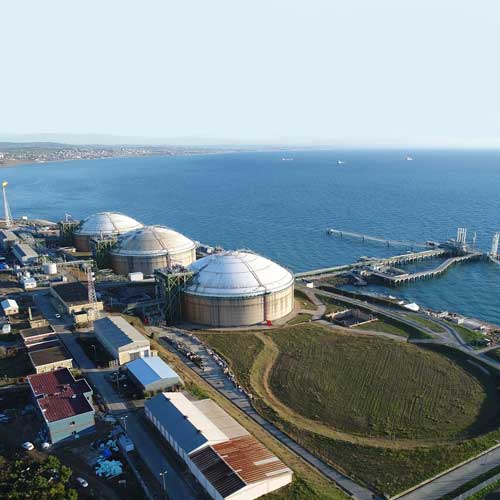LNG Terminal
- Home
- LNG Terminal
- Concrete Chimney for Factory
- Bridge and Viaduct Pillar
- Continuous Emission Monitoring Systems
- Concrete Silo Solutions
- Crane Solutions
- Minaret (Sliding mold) Solutions
- New Cement Factory Construction Solutions
- Old Cement Factory Restoration Solutions
- Post Tension Solutions
- Power Plant (Thermal, Solar, Energy, Wind) Solutions
- Raw Meal Silo Solutions
- Sliding Mold Solutions
- Steel Construction Solutions
- Treatment and Digestion Silo
- Slip Form Solutions
- Special Production Machinery Manufacturing
- Freight Elevators
- Waste Water Treatment Plant
- Refractory (Fire Bricks)
- LNG Terminal
- Climbing Formwork Solutions
What is LNG?
When natural gas is cooled down to -162°C at atmospheric pressure, it condenses into the liquid phase and is called “LNG-Liquified Natural Gas”. LNG is an odorless, colorless and non-toxic liquid fuel. Liquid transportation and storage operations are carried out. During consumption, LNG is offered for consumption in gaseous form. It is possible to store large amounts of natural gas in liquid form with LNG, reducing its volume by about 600 times at low pressures. This feature makes it convenient to transport and store natural gas by ship and tanker in places where it is not possible to technically and economically transport natural gas. The removal of heavy hydrocarbons in natural gas during the liquefaction stage ensures that LNG is cleaner and has a higher energy value than pipeline natural gas. Natural gas, which mainly contains methane (90%), contains ethane, propane and other heavy hydrocarbons. Natural gas; It contains few pollutants such as nitrogen, oxygen, carbon dioxide, sulfur compounds and water, but it is cleaner than natural gas as the contaminants are removed during liquefaction of LNG.

Advantages of LNG
- High Quality Systems
- Fast Building
- Experienced Team
Storage and Transport of LNG
LNG is more difficult to store or transport than natural gas. First of all, heat exchange between the insulation and the air is prevented and there is an average of 25 bar pressure in the tanks. Although it is difficult to transport, it does not pollute the environment and provides commercial savings due to its low pollution index.
